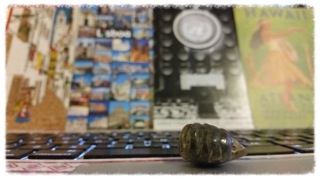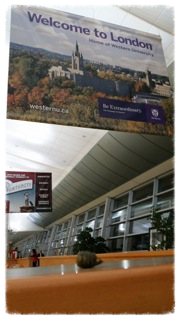Tortuga Hive, Summer 2014
Consistent with other pieces associated with the Carving Vignettes program that participate in the Global Art Project, this carving is guided by a comparative reading of pre-Columbian Mesoamerican and Andean interpretations regarding the intricate relationship between the arc of the horizon and the movement of light as well as complimentary Eurasian insights regarding physical balance, “celestial bundling” and a “cosmic egg.” When we nudge the carving very gently in either direction horizontally, for example, it neatly “floats” while a similar result can be achieved when the carving is balanced vertically, with nose pointing upwards. The remarkable rock was first encountered just below where its introductory portrait was taken, on the banks of the North Saskatchewan River underneath the historic Low Level Bridge. Meanwhile, the carving emits periodic flashes of blue light when it is moved in any direction and during the carving process, its brazen head continued to “pop out” of its hive-like body. Part of the original inspiration for the sculpture was derived from explanations provided to the School of One by a Cree intellectual regarding the origins and meaning of the name Maskwacis, and the piece celebrates the exemplary academic achievements of First Nations students at the University of Alberta.
London Re-Calling
The following travel journal by P.J. recounts a period of isolated introspection in Ontario during mid-Winter, 2014-2015. P.J. originates from the four Nations community of Maskwacis, linked to Edmonton by a ribbon of 2A-asphalt tacked onto part of a boundary between the Ermineskin Cree Nation and the Samson Cree Nation, Central Alberta. P.J. was recognized by the Faculty of Arts for exemplary academic achievements as an undergraduate at the University of Alberta and subsequently has traveled throughout the world in an endless pursuit of knowledge, learning, and scholarly excellence. As the travel journal marked by the carving Tortuga Hive recalls, P.J.’s academic journey includes doctoral studies in Anthropology at the University of Western Ontario in the Territory of Turtle Island. The following vignettes confirm that this doctoral student’s experience is buttressed by readings of Cree scholarship and is always informed by an attachment to home, family and cultural remembering of place found at the crossroads of the past, present and future.
I sit at my desk and wonder about how far I have come and where I am going. I look at the books in front of me and think about every word I have read and how it has changed my outlook, infuriated me, or motivated me. I have read the stories of our grandmothers, how we retain our knowledge, and how we share what we know. Much of what I read is intrinsically bound to culture and tradition. Reading these pieces from Cree scholars I feel at home, and London does not seem so far away. I know that beside me stand my ancestors who have long since past and the feelings of loss and loneliness fade away. I am never alone, and the cold wind that howls outside has no impact on me, as my home fire burns bright inside my apartment.
It has been a long day coming, nearly two years ago I graduated with a M.A. in History. Today I received my stole from Indigenous Services, and I could never be more pleased. It is better late than never as the University crest sits next to the logo representing the Haudenosaunee and their traditional wampum belt. Traditionally made of quahog shells, wampum belts are carefully woven together to create intricate designs and symbolically represent understandings between two or more parties. Indigenous Services design takes a positive approach to supporting Indigenous students self-determination through spirit and traditional ways. Many key principles (including balance, collaboration, and diversity) are represented within the belt and, together, encourage a new perspective into how Indigenous peoples retain their knowledge and insights outside written text. This is Turtle Island, and though this is not my territory or tradition, I am welcomed and warmed.
A deadline upon meetings on top of reading and classwork – but it is all in a day’s work and I am going to give it “the old college try.” Everything is meant for a reason, and I look forward to sharing my knowledge and reminisce on the places I have gone and how my journey is just beginning. The post cards of Honolulu, Hawaii, New York at the UN, and Lisbon, Portugal give me a reflection of my experience and how liberating it has been to share what I have learned and what I have yet to learn. I want to emancipate Indigenous voices and liberate our knowledge from the colonial grips of misunderstanding and injustice. That is my motivation. This is who I am. And I can guarantee all of these places are warmer than the Great Lakes region as we speak. The winter is different than the last two I have spent here, and I worry about our mother.
Okimaw, Chief, is finally asleep and this comes after playing with his stuffed dragon for nearly an hour. I love his company and how he talks to me about everything. I can attest that Siberian Huskies do love to talk and howl. He gives me comfort and checks on me frequently as I read and will occasionally sleep underneath or near my desk when I am working. He is my okimaw, and if he loves the snow, then I do too.
I am working on my Ph.D. at the University of Western Ontario in London, Ontario. I have had my ups and downs since leaving home. I will not lie: It has been hard being away from family and not being able to see my grandfather or parents. The days go by fast, but the moment the sun leaves and the evening sky and stars appear it feels like an eternity. I have to remind myself one day at a time and that I am here for a reason. I sit waiting for my plane looking at the poster hanging from the ceiling welcoming you to London, but all I can think of is I cannot wait to go home. After this hard part of my journey, only two more years. I can do this.
For a brief introduction into the history of Maskwacis, please see the article and associate video:
Mark Klinkenberg, “Drumming and Dancing and Celebration Herald a New Beginning for Maskwacis, Formerly Hobbema,” Edmonton Journal, (January 1, 2014).
For useful links electronically in and around Turtle Island, please see Turtle Island Native Network





